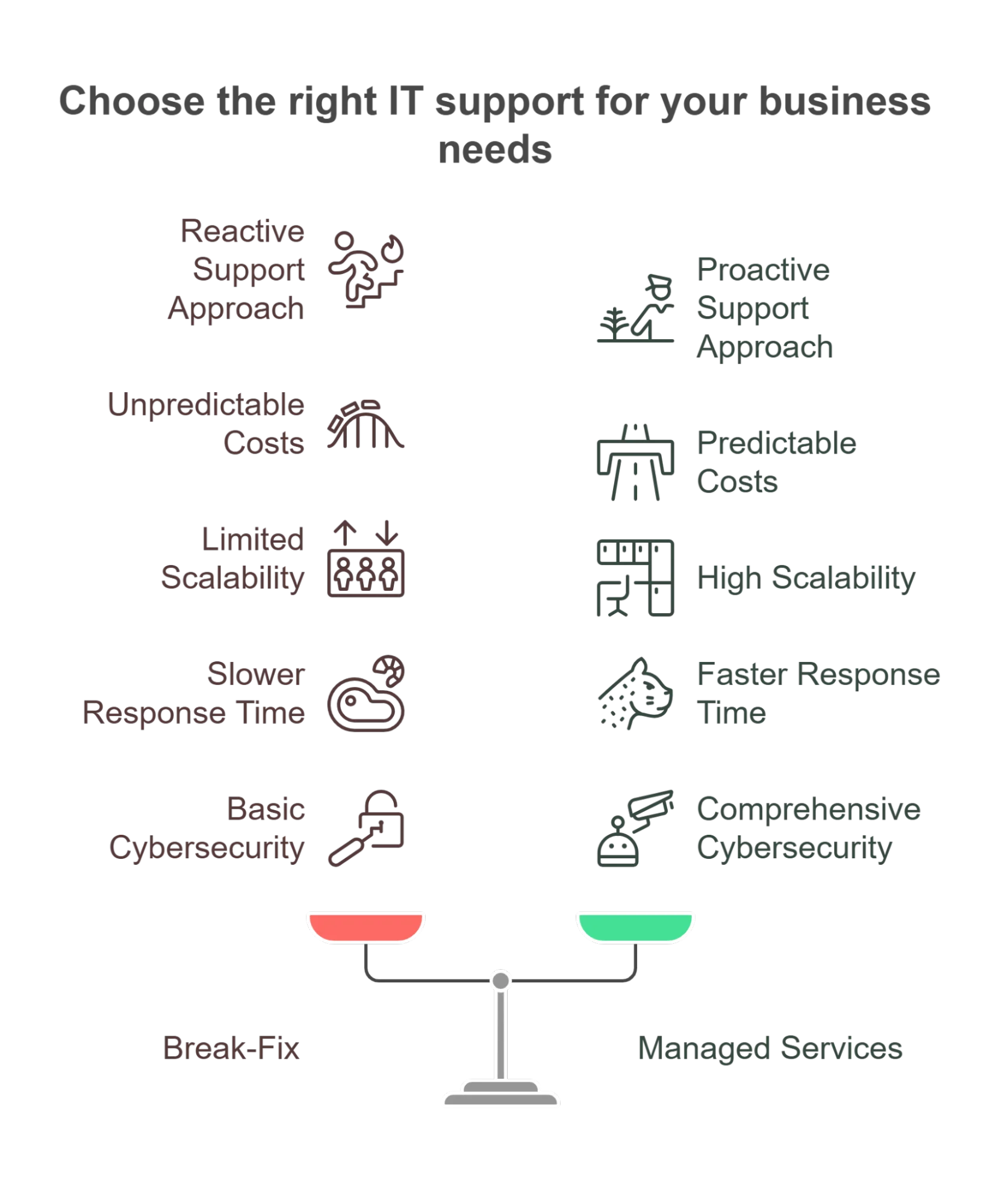If your business is still reacting to IT problems as they happen, you’re exposing yourself to financial risk, security vulnerabilities, and operational headaches that are entirely avoidable.
Research shows that 50% of IT downtime is avoidable, highlighting just how much of the disruption businesses face can be prevented with the right IT strategy. That means half of the interruptions businesses face – lost hours, frustrated teams, missed opportunities – didn’t have to happen. They’re often the direct result of reactive IT strategies, like the traditional break-fix model.
Every hour your systems are down could cost you thousands. And it’s not just about dollars – it’s about reputation, compliance risk, and your team’s ability to function efficiently.
| As Anthony Moussa, CEO of MooIT Solutions, says, “Proactive IT strategies reduce downtime and boost operational efficiency more than reactive support ever can.” |
So, how do you stop this costly cycle before it starts? It begins with understanding your options.
In this blog, you’ll get a clear, no-nonsense comparison of brea-fix vs. managed services. We’ll cover what each model involves, the core differences, and how to decide which approach fits your business goals.
Break-Fix vs. Managed Services: What’s the Real Difference?
Let’s start by defining each approach thoroughly, because if you don’t know exactly what these models entail, you can’t choose the right one.
What Is Break-Fix?
Break-fix is the traditional model of IT support. It’s a reactive service approach – you only call in IT professionals when something goes wrong. Think of it like calling a plumber after a pipe bursts.
There’s no ongoing relationship, no monitoring, and no preventative work. Instead, you pay per incident, typically by the hour or by the job. Once the issue is resolved, the technician moves on.
Examples of Break-Fix Situations:
- Your email server crashes, and you need it restored.
- A workstation won’t boot and requires repair.
- A virus infects your network, and a technician is called in to remove it.
Break-fix may seem appealing for businesses with limited IT needs or tight budgets. However, it has serious drawbacks, especially as your tech needs grow in complexity.
What Are Managed Services (MSPs)?
Managed Services involve partnering with a managed service provider (MSP) for ongoing, proactive IT support. Instead of waiting for things to break, your systems are continuously monitored, maintained, updated, and secured.
You pay a fixed monthly fee for a suite of services, which typically include:
- 24/7 network monitoring
- Data backups
- Cybersecurity protection
- Remote and on-site support
- Hardware and software management
This model is like hiring an outsourced IT department – complete with specialists who understand your business, your systems, and your goals.
It’s no surprise that 46% of businesses now use managed IT services – the benefits of proactive support, predictable costs, and expert guidance are too valuable to ignore.
Now that the definitions are clear, let’s explore the significant differences between these two models.
Take Control of Your IT CostsSay goodbye to unpredictable expenses with flat-rate, fully managed support from MooIT. |
1. Proactive vs. Reactive Support
Break-Fix: This model is 100% reactive. You wait for an issue to occur, and only then do you reach out for help. While this might seem cost-effective upfront, it often leads to extended downtime while you try to find help, and you’ll probably be one of many clients in the queue.
Managed Services: MSPs focus on prevention. They monitor your network in real time, detect potential problems before they disrupt operations, and perform regular maintenance. This means fewer emergencies, smoother performance, and greater long-term reliability.
Bottom Line: If you can’t afford unplanned downtime, a proactive model like managed services is essential.
2. Cost Predictability and Budgeting
Break-Fix: Costs are unpredictable. You don’t pay unless something goes wrong, but when it does, you’re on the hook for possibly high fees, especially if the issue is urgent or complex. This unpredictability can wreak havoc on budgeting, especially for small and mid-sized businesses.
Managed Services: You pay a flat, monthly fee for consistent service. You know what to expect each month and can plan accordingly. There may be additional charges for hardware or special projects, but the core support costs are predictable.
Bottom Line: If consistent budgeting is essential, managed services are the clear winner.
3. Scalability and Flexibility
Break-Fix: This model doesn’t scale well. As your business grows, so do your IT needs. More devices, more endpoints, and more systems lead to more opportunities for failure and more service calls. Break-fix can quickly become inefficient and chaotic.
Managed Services: MSPs are built for scalability. Whether you’re adding new employees, opening new offices, or transitioning to remote work, your provider adapts your support plan accordingly. You get access to more expertise and resources without hiring internally.
Bottom Line: Growing businesses need the flexibility that comes with a scalable IT model – something break-fix just can’t offer.
4. Response Time and Support Quality
Break-Fix: Response time can vary significantly depending on technician availability. You’re often dealing with third-party contractors who don’t know your systems. In urgent situations, you might pay more for expedited service.
Managed Services: MSPs typically offer Service Level Agreements (SLAs), guaranteeing response times and service quality. They know your environment, monitor it 24/7, and often resolve issues before you even know they exist.
Bottom Line: When speed matters, managed services offer the reliability and continuity break-fix can’t match.
5. Cybersecurity and Compliance
Break-Fix: Security is not built into the break-fix model. If a breach occurs, you’ll need to bring in a specialist – often at a premium rate – and recovery can be slow and incomplete. Compliance? That’s your responsibility to manage alone.
Managed Services: Security is often a core part of MSP offerings. This includes:
- Firewalls
- Endpoint protection
- Patch management
- Security audits
- Compliance support for regulations like HIPAA, PCI, or GDPR
Proactive cybersecurity is essential in today’s threat landscape, and MSPs provide enterprise-level protection tailored to your business.
Bottom Line: Don’t gamble with cybersecurity. MSPs offer far stronger defense than the break-fix model ever could.

Which IT Support Model Fits Your Business Best?
| Decision Factor | Break-Fix | Managed Services |
| Business Size & IT Complexity | Suitable for small, simple setups | Ideal for businesses with multiple locations, hybrid environments, or complex systems |
| Compliance Requirements | No compliance guarantees | Helps meet standards like HIPAA, GDPR, PCI-DSS |
| Budget Predictability | Costs are unpredictable and can spike | Fixed monthly pricing ensures financial stability |
| Internal IT Staff Availability | Requires in-house knowledge or ad-hoc support | Supplements or replaces internal IT with expert-level service |
| Scalability Needs | Struggles to scale efficiently | Scales easily as your business grows |
| More articles you might like: |
Choose the IT Model That Moves Your Business Forward
Choosing between break-fix vs. managed services isn’t just a technical decision – it’s a strategic one that directly impacts your business performance, cost control, and long-term success.
Break-fix might work for small businesses with minimal IT needs, but it comes with unpredictability, downtime risk, and a lack of long-term protection. On the other hand, Managed Services give you stability, proactive monitoring, faster issue resolution, and critical cybersecurity – all under a predictable budget.
If your business is growing, handling sensitive data, or simply can’t afford IT disruptions, Managed Services aren’t just better – they’re essential.
At MooIT, we specialize in helping businesses transition from reactive IT chaos to proactive, fully managed solutions tailored to their needs. Whether you’re scaling fast or simply want peace of mind, MooIT delivers enterprise-level support designed to keep you ahead of problems, not behind them.
Contact us today to schedule your free consultation and see how our Managed Services can transform your IT from reactive to resilient.
|
Discover Trusted Managed IT Services Near You |



